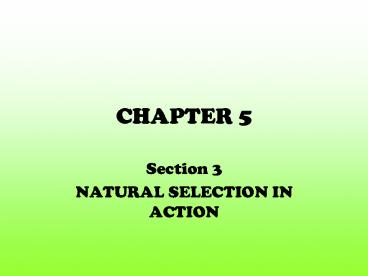NATURAL SELECTION IN ACTION - PowerPoint PPT Presentation
Title:
NATURAL SELECTION IN ACTION
Description:
CHAPTER 5 Section 3 NATURAL SELECTION IN ACTION INSECTICIDE RESISTANCE Farmers use a wide variety of chemical insecticides to protect their crops. – PowerPoint PPT presentation
Number of Views:24
Avg rating:3.0/5.0
Title: NATURAL SELECTION IN ACTION
1
CHAPTER 5
- Section 3
- NATURAL SELECTION IN ACTION
2
INSECTICIDE RESISTANCE
- Farmers use a wide variety of chemical
insecticides to protect their crops. - However, some insecticides that worked well in
the past are no longer as effective.
3
GENERATION TIME
- Insects quickly develop resistance to
insecticides because they produce many offspring
and usually have short generation times. - GENERATION TIME- is the period between the birth
of one generation and the birth of the next
generation. - LOOK AT FIGURE 16 ON PAGE 118.
4
ADAPTATION TO POLLUTION
- Before pollution the dark peppered moth stood
out against the light backgrounds and as a
result were eaten more frequently.
5
- After the pollution, the light peppered moth
stood out against the dark backgrounds and as a
result were eaten more frequently. - So the dark moths survived and produced more dark
offspring.
6
FORMATION OF A NEW SPECIES
- A portion of a species population can become
separated from the original population. Over
time, the two populations can become so different
that they can no longer interbreed. This process
is called SPECIATION. One way speciation can
occur is shown in the following 3 steps.
7
1) SEPERATION
- A portion of the population becomes isolated.
Examples could be the formation of a canyon,
mountain range, or lake.
8
2) ADAPTATION
- If a population is divided, the environment may
also change. - Over many generations, the separated group may
adapt to better fit their environment.
9
3) DIVISION
- After many years (hundreds, thousands, or
millions) the two populations are so different
that they can no longer interbreed.they are NO
LONGER the same species.































